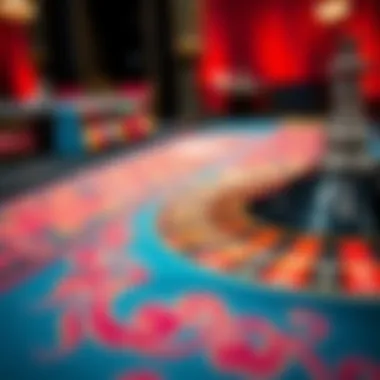Exploring the Roulette Table Cloth: Design and Impact


Intro
When you step foot into a casino, you’re immediately enveloped by the buzz of excitement and the glimmer of lights. Among the numerous elements that entice players, the roulette table stands out. However, an often-overlooked but crucial aspect of the roulette table is its cloth. This piece of fabric is not just an afterthought; it plays a pivotal role in shaping the gambling experience. The roulette table cloth is a confluence of design, functionality, and cultural significance, impacting how players engage with the game.
Understanding the intricacies of the roulette table cloth reveals much about the casino environment. It’s not just a simple layout; rather, it's a tapestry of history interwoven with modern trends. The materials used, the artistry behind its design, and the psychological effects on players all create a unique gaming atmosphere that cannot be ignored.
In this exploration, we’ll thoroughly dissect the components of roulette table cloths, examining their design attributes, functionality, and broader cultural implications. From the age-old traditions influencing table aesthetics to innovative customization options that cater to a new generation of gamblers, every aspect deserves attention.
We will also dive into the significance of maintenance and market considerations, providing insights that benefit both casino operators and curious players. This article aims not only to educate but also to enhance appreciation of this essential element of the gambling world.
Buckle up as we embark on this journey through the captivating realm of the roulette table cloth, where every stitch tells a story.
Game Mechanics and Strategies
In the world of roulette, understanding the game’s mechanics is paramount. The way the table is set up and the cloth itself plays a crucial role in the experience.
Understanding the Rules of Popular Games
Roulette’s charm lies in its simplicity and unpredictability. The game consists of a spinning wheel and a flat betting table, where players place their bets on numbers or colors. The table cloth, adorned with the layout of the betting options, provides a visual guide that facilitates gameplay.
- Layout of the cloth: The numbers arranged on the cloth, from zero to thirty-six, allow bettors to place their wagers quickly and intuitively.
- Color-coded sections: The red and black segments guide players, making it easier to decide on bets. The placement of the green zero adds an element of risk, changing the odds slightly in favor of the house.
Every spin of the wheel ushers in a dance of chance—a compelling blend of risk and strategy that many players find exhilarating. This dynamic nature keeps players returning, eager to test their luck and strategies.
Advanced Strategies for Winning
While luck plays a significant role in roulette, seasoned gamblers often employ various strategies to mitigate risk and enhance their gaming experience. The choice of table and cloth can influence these strategies as well.
- The Martingale strategy: This widely known betting system involves doubling your wager after each loss, all with the hope of recouping previous losses when you finally win. The vibrant colors and clear markings on the roulette cloth aid in tracking bets effectively.
- The Fibonacci system: This strategy leverages the famous Fibonacci sequence, adjusting bets based on a specific numerical pattern. The layout of the cloth makes it easy to visualize bet placements.
Proper understanding of these strategies can create more engaging and thoughtful gambling experiences. Taking into account the aesthetic and functionality of the roulette table cloth can only enhance the overall strategy employed.
“The table cloth is not merely a decorative piece; it is a fundamental component that shapes the entire gambling atmosphere.”
As we continue through this journey, we will delve into the cultural significance of the roulette table cloth and how it has evolved over time.
Preface to Roulette Table Cloths
Roulette table cloths might seem to be the unsung heroes of the casino world. Often taken for granted, they play a crucial role in not just game functionality but also in setting the atmosphere of the gaming environment. A well-designed cloth can evoke a sense of excitement, elegance, and even anticipation as players gather around to place their bets. This article delves into their multifaceted importance, spotlighting how these seemingly simple items contribute to the broader casino experience.
Historical Overview
The origins of the roulette table cloth date back to the early days of gambling, when tables were simple wooden structures draped in cloth for durability and aesthetics. In the heated casinos of France and later America, the evolution of the roulette table cloth mirrored the growth of the game itself. Each era brought unique colors and designs, from lavish brocade in the 19th century to bright, synthetic fabrics of the late 20th century. The composition of these tablecloths reveals much about the social and cultural dynamics of gambling, especially in regions known for their distinctive styles. For instance, in Monte Carlo, you might find tablecloths that echo the opulence of the Riviera, while American casinos often favor more subdued hues, perhaps reflecting a sense of practicality combined with flair.
Importance in the Casino Environment
The role of roulette table cloths transcends mere decoration. They are fundamentally intertwined with the experience of gameplay. A flashy cloth can draw in players, creating an inviting and thrilling atmosphere that heightens the excitement. The colors and patterns used can also help guide player behavior, subtly encouraging them to engage more deeply with the game. Moreover, high-quality materials enhance the tactile experience, which is crucial when players are making quick decisions during intense game action.
"A roulette table cloth isn't just about function; it's about creating an environment where players feel they are part of something extraordinary."
In understanding the dynamics of casino design, one must recognize how these cloths serve not only a practical purpose but also a cultural one. They offer a glimpse into local traditions and preferences, providing operators insight into regional tastes and expectations. This knowledge can help casinos enhance their branding and create a signature experience that resonates with their clientele.
In summary, the significance of roulette table cloths extends far beyond their practical applications. They connect the historical and cultural threads of gambling while actively shaping the contemporary casino experience.
Design Elements of Roulette Table Cloths
The design elements of roulette table cloths serve a critical role not just in aesthetics but also in functionality and player experience. The intricate relationship between design and usability shapes how enthusiasts interact with the game. Therefore, understanding these elements can encourage casino operators to optimize their environments for both engaging design and immersive gaming.
Color Schemes and Symbolism
The choice of colors for a roulette table cloth is far from trivial. Each hue carries weight, influence on mood, and even significance in gambling traditions. Traditionally, the color red often screams excitement and passion, synonymous with the thrill of wagering, while black can evoke a sense of elegance and sophistication. These colors are not merely chosen for their physical appearance; they symbolize the dual nature of luck and risk present in gambling.


Interestingly, some casinos opt for greener shades on their cloths to create a calming effect, promoting focus amid the chaotic energy of the casino floor.
In essence, color schemes on these fabrics do not just frame the game; they play a psychological role in influencing player decisions. Often players make impulsive bets, swayed by their emotional response to the colors surrounding them, thus linking aesthetics to their fate at the wheel.
Patterns and Layouts
The layout and patterns on roulette table cloths are crafted with precision. The design needs to facilitate not just visual appeal but also gameplay efficiency. Imagine a cloth designed with a cluttered, chaotic pattern—players might struggle to read values quickly or misinterpret positions, which could hinder a pleasant gaming experience.
Typical arrangements feature well-defined sections that clearly delineate where to place bets. The classic roulette layout offers specific areas for bets on individual numbers, colors, and other groupings. This structure enhances clarity, permitting players to place their wagers effortlessly.
However, variations in pattern designs—ranging from more modernist or thematic interpretations—can attract diverse customer bases. High-end casinos might opt for bespoke designs that reflect local culture or even luxury brands. This strategy not only enhances the visual appeal but can also cultivate a unique club atmosphere that players want to be part of.
Influences of Modern Art
The intersection of modern art and design is perhaps one of the more fascinating aspects of roulette table cloths. Many designers draw inspiration from contemporary art movements to recontextualize the casino experience. Art-inspired table cloths can tell stories or evoke specific feelings, becoming part of the overall aesthetics of a modern gaming establishment.
For instance, a cloth featuring abstract designs might create a vibe of creativity and innovation, appealing to younger players who value experiences beyond conventional gaming. Utilizing bold strokes, geometric shapes, or even collaboratives with local artists can create a sense of community and cultural significance.
Additionally, leveraging modern art in table cloth design could enhance brand motifs for casinos, aligning them with creative expression and offering players a unique artful engagement while gaming.
In summary, the design elements of roulette table cloths are essential for fostering an engaging environment for players. Color schemes, patterns, and influences of modern art not only elevate the visual appeal but also enhance functionality and the gaming experience itself.
Materials Used in Table Cloth Manufacturing
The material choices for roulette table cloths play a significant role in how they perform and influence the gaming atmosphere. Different fabrics bring unique benefits and considerations that not only shape the aesthetic appeal but also affect the gaming experience itself.
Selecting the right material impacts not just how a table cloth looks, but also how it feels under the hands of players. The texture influences the tactile sensation while placing bets, which in turn contributes to the players’ engagement. Comfort and visual appeal are joined at the hip when it comes to a table cloth's effectiveness in a casino setting.
Moreover, different materials come with their own set of maintenance requirements and durability. Casino operators must consider the operational costs associated with each type of fabric—some require more frequent replacement due to wear and tear, while others may serivably outlast their competitors.
Fabrics and Textures
When it comes to fabrics, the primary choices for roulette table cloths typically include wool, polyester blends, and felt. Wool adds warmth and a premium feel, which can elevate the overall ambiance of the room. This type of fabric tends to resist stains and spills better, making it a favorite choice for high-stakes tables. However, it can be on the expensive side.
Polyester blends bridge the gap, providing cost-effective options without sacrificing too much on quality. They are often used in standard casinos and are known for their vibrant colors and patterns. The smooth texture can facilitate easy chip movement, which might encourage players to feel more comfortable.
Felt, commonly seen on more casual tables, offers a different experience altogether. Its soft, fuzzy surface can enhance tactile interactions, making it popular in home game settings but less so in upscale environments.
In the world of roulette, the texture is just as important as the visual design, often playing a pivotal role in whether players feel at ease or on edge.
Durability and Maintenance Considerations
Durability is a key factor when discussing casino table cloths. Casinos can’t afford to have shabby-looking tables, as a worn-out cloth can give the impression of neglect or unprofessionalism. The amount of use a cloth sees directly affects how long it will last.
- Stain-resistance: Some fabrics are treated to repel spills, an essential feature when cascading chips and drinks are a common sight.
- Washability: Being able to clean a cloth quickly is a must. Materials that can be machine-washed or spot-cleaned can significantly reduce maintenance time.
- Fade-resistance: Over time, exposure to artificial lighting can cause colors to fade, chipping away at the cloth’s visual appeal.
Choosing a table cloth material without considering these aspects can lead to frequent replacements and a hit to the casino’s environmental bottom line. The trend seems to shift towards investing a bit more upfront for quality materials that ensure longevity over the long haul.
"Materials dictate a roulette table cloth's life; investing in quality ensures less hassle down the road."
Functional Aspects of Roulette Table Cloths
The functional aspects of roulette table cloths play a pivotal role in the overall gambling experience. It goes beyond mere aesthetics to serve practical purposes that can significantly impact both gameplay and player satisfaction. Gamblers seek not just a game—they desire an environment that heightens their engagement and enjoyment. High-quality table cloths are vital in establishing this environment.
Impact on Game Play
The way a roulette table cloth is designed can profoundly affect the mechanics of gameplay. For instance, uneven or poorly maintained surfaces can disrupt the smooth motion of the wheel and chips. Furthermore, the material used affects how chips slide across the cloth, influencing player strategy. Certain fabrics offer a friction coefficient that can enhance or hinder gameplay. Players often find themselves adapting their betting techniques based on how the chips respond on the cloth surface.
"A roulette table isn’t just a gambling spot; it’s a stage where fortunes are made and lost, with the table cloth being the silent actor that can sway the plot of the game."
Uniform and clear markings are crucial as well. A thoughtfully designed roulette cloth features distinct sections for bets, allowing players to place their chips with confidence. If these markings are unclear or smudged, players may misinterpret where to place their wagers, affecting both their experience and outcomes.


Enhancing the Player Experience
The player experience in a casino is influenced by numerous factors, and the table cloth is no exception. A well-crafted cloth can significantly elevate the atmosphere of a gaming session. For example, a cloth with vibrant colors and intriguing patterns can create an engaging ambiance, drawing players’ attention and enhancing their emotional investment. When players feel absorbed in their surroundings, they are likely to spend more time at the table, increasing revenue for casinos.
In addition, the tactile experience of the cloth contributes to comfort and satisfaction. Players enjoy the sensation of smooth, well-maintained materials against their hands as they engage in the game. Fabrics that feel rewarding under the touch can turn a simple gambling session into a luxurious experience. Moreover, a clean and fresh-smelling table cloth encourages prolonged play, as players are more inclined to settle in for longer durations if they feel welcome in their environment.
In a nutshell, the functional design elements of roulette table cloths not only influence the technical aspects of gameplay but also contribute to the emotional and psychological comfort of players. Striking a balance between functionality and aesthetic appeal therefore becomes a crucial consideration for casino operators.
Cultural Significance of Roulette Table Cloths
The role of roulette table cloths transcends mere utility; they embody a rich tapestry of cultural traditions and values intertwined with the gambling experience. The colors, patterns, and materials chosen for these cloths often reflect the setting in which they are used, serving not only to enhance gameplay but also to create an ambience that resonates with players and onlookers alike. Various elements of design invoke specific emotions, aspirations, and sometimes even superstitions which are deeply rooted in the culture of gambling. Understanding these layers can significantly enhance appreciation for the artistry involved in creating these cloths and the meaning they hold in the broader context of casino life.
Symbolism in Gambling Culture
In gambling culture, symbols have power. With roulette table cloths, this holds true; they resonate with players in ways that influence not only their experiences but also reflect their beliefs. Colors such as green often symbolize good fortune and fertility, while red and black are frequently associated with luck in various cultures. The arrangement of numbers is not arbitrary either. Each number on the layout has significance, and many gamblers have lucky numbers or patterns they feel drawn to. This unique blend of cultural symbolism and personal belief creates a complex relationship between players and the table cloth itself.
For instance, in China, the color red symbolizes happiness and good luck, which might influence casinos in Asia to favor vibrant reds for their table layouts, while European casinos may lean towards more muted tones, reflecting a different attitude towards luck and gaming. Moreover, the act of placing bets often carries ritualistic importance, adding emotional depth to gameplay that mere statistics can’t capture.
"The cloth becomes a canvas for gamblers' ambitions, dreams, and cultures."
Regional Variations and Preferences
Diving into geographical differences reveals even more about the cultural significance of roulette table cloths. In Las Vegas, the clamor of excitement and bright lights often leads to bolder designs, where the cloths are almost as flashy as the games themselves. In contrast, European casinos traditionally adopt a more understated approach, opting for classic fabrics that convey elegance and sophistication. The way a roulette table cloth is designed often mirrors the casino's larger aesthetic and philosophy.
Furthermore, certain patterns may appeal more in some regions than others; for example, intricate designs might be favored in some Asian gaming houses, reflecting a local taste for detailed art and craftsmanship. The choice of fabric—canvas, felt, or silk—can also be influenced by cultural preferences for tactile experiences during gameplay, considering aspects of both comfort and slip resistance, which directly impacts the performance of the game.
Casinos, aware of these regional nuances, often customize their roulette table cloths not only to fit their brand identity but also to align with the cultural expectations of their clientele. Each cloth unfolds layers of regional identity, serving as a heuristic for the lifestyle and gambling behaviors prevalent in each locale. By incorporating local flair into design, casinos reinforce their image and foster loyalty among players.
Customization of Roulette Table Cloths
Customization of roulette table cloths sits at the intersection of art and commerce. In the competitive world of casinos, having a unique identity helps set one establishment apart from another. A well-designed table cloth does more than simply cover the gaming surface; it becomes a significant tool in branding and enhancing the overall experience for players.
Many casinos invest heavily in creating distinct table cloths that reflect their brand's ethos. These colorful, symbolic designs tell a story and provide a visual connection to the casino's themes. When visitors step into a facility, they should feel welcomed and enchanted. A tailored table cloth can contribute towards this ambiance.
Branding Opportunities for Casinos
The design of a roulette table cloth serves as an advertisement for the casino. A unique logo on a table cloth can act as a calling card of sorts, especially when combined with thematic colors and graphics that resonate with the casino's broader design elements. For instance, a high-end casino might choose rich fabrics that incorporate their logo subtly woven into the cloth's textures, exuding elegance without overwhelming the senses.
Consider the Las Vegas Strip; it's not uncommon to see table cloths featuring motifs that reflect local culture or casino branding. These designs might incorporate elements like the arch of the famous "Welcome to Fabulous Las Vegas" sign or the lush landscape that surrounds the area. This adds a layer of authenticity and can enhance emotional engagement—a vital component in customer retention.
"Customization is not just about aesthetics; it’s a strategic choice that can shape player perceptions and elevate the overall experience."
Casino operators must weigh the costs and benefits of customization options. From the material used to the printing techniques employed, decisions can influence durability, maintenance, and player interaction. A table cloth that wears out quickly—perhaps made from a flimsy fabric—negates the investment in design. Ideally, choices made in this regard reflect not only functionality but also the casino’s vision.
Personalization for High Rollers
High rollers, often the lifeblood of any casino, can influence design choices significantly. Personalizing roulette table cloths for this exclusive group can add to their luxurious experience, making them feel valued and recognized. Simple touches, like embroidering their name or monogram onto the cloth, can reinforce their sense of prestige.
Moreover, high-stakes games often attract attention, and having customized designs can turn these tables into eye-catching focal points of a casino floor. Special fabric selections or exclusive patterns can amplify the allure, making the experience memorable not just for the players themselves but also for onlookers. Such personalization can lead to word-of-mouth referrals; satisfied patrons are likely to recommend the casino based on their bespoke experiences.
Incorporating player feedback when customizing these elements further enhances loyalty. Engaging with high rollers to understand their preferences fosters a sense of community where they feel their opinions matter. This dynamic can result in a more personalized gambling experience, creating an emotional investment that is often reflected in their gaming habits.
In summary, the customization of roulette table cloths goes beyond mere aesthetic appeal. It's a vital component in brand strategy, player experience, and customer engagement, defining the character of a casino in material and style. As trends evolve, so does the potential for creativity in tailoring these significant pieces, ensuring they meet the demands of both functionality and cultural importance.
Market Trends in Roulette Table Cloths
The game of roulette is as much about the thrill of chance as it is about the atmosphere that surrounds it. One might not immediately see the significance of the roulette table cloth in the overall casino experience, but its role is pivotal, making it a worthy topic of discussion. Today, we dive into market trends in roulette table cloths, which reflect broader shifts in casino design, player expectations, and technological advancements. Through understanding these trends, both casino operators and players can appreciate how these elements can enhance or detract from the gaming experience.
Innovations in Material and Design
As casinos evolve, so do the materials and designs of the table cloths. Modern innovations have revolutionized what once were simple fabrics, introducing high-tech options that improve durability and aesthetics. Synthetic materials such as microfiber and blended textiles provide enhanced stain resistance, moisture control, and longevity. Not only do these materials keep the cloth looking sharp, but they also prolong the life of the product, saving costs for casino operators in the long run.


Moreover, design has taken a leap forward. Traditional colors—usually a deep green or red—are gradually being replaced or complemented by vibrant hues, which create a more inviting atmosphere. Further, incorporating elements of local culture into designs can strengthen a casino's brand identity and appeal to tourists.
Some materials and designs worth noting include:
- Heavy-duty polyester: Known for its durability and resistance to pilling.
- Nano-coating: A modern innovation that repels water and stains.
- Custom graphics: High-resolution prints that can feature local landmarks or themes which resonate with visitors.
"The table cloth is no longer just fabric; it’s an integral part of the casino's story and atmosphere."
Consumer Preferences and Buying Patterns
Understanding consumer preferences is key to staying ahead in the competitive environment of casinos. Players today are discerning and often associate the quality of the table cloth with the overall experience at a casino. This has led manufacturers to cater to these evolving tastes more closely.
Now, gamblers look for more than just functionality; they seek an experience that feels luxurious and personally tailored. High rollers, in particular, may seek out personalized table cloths that reflect their status. Casinos recognize this and have begun offering customization options, from logos to bespoke designs that communicate exclusivity.
When it comes to buying patterns, casinos have shifted from purchasing in bulk to focusing on quality and uniqueness. This can mean investing more in a few high-quality designs rather than skimping on the quality across many tables. Additionally, the trend of online ordering and customization has risen. It allows operators to quickly adapt to trends and preferences without the lengthy waits of traditional procurement processes.
In summary, the trends in roulette table cloths reflect a much wider shift in the gambling community. Improved materials and design innovations dovetail perfectly with players’ desires for personalized experiences—this is no longer just about chance; it's about creating a memorable atmosphere.
For further resources and trends, you can check:
- Wikipedia: Roulette
- Britannica: Roulette
- Reddit discussions on gambling aesthetics
- Casino Design Insights
Case Studies of Notable Roulette Table Cloth Designs
The study of notable roulette table cloth designs reveals a lot about the interplay between aesthetics and functionality within the casino environment. Each design does not simply serve a purpose but carries with it a narrative, reflecting the culture and brand ethos of the establishments it represents. By examining specific examples, we gain insight not just into the design elements themselves but also into the broader implications for player engagement and casino identity.
Iconic Designs from Renowned Casinos
Across the globe, many casinos are known for their distinctive roulette table cloths that leave a lasting impression on players and visitors alike. For example, the Monte Carlo Casino in Monaco showcases a rich velvet fabric adorned with deep red hues and golden accents, evoking a sense of luxury and opulence. This choice of colors and materials establishes an ambiance that draws players into a world of glamour, prompting them to partake in high-stakes games with heightened enthusiasm.
On the other side of the world, the Venetian in Las Vegas opts for a vibrant design, intertwined with the artwork of the famous Italian city. Imagery of gondolas and canals subtly integrated into the fabric creates an immersive experience that transports players away from the neon lights of Vegas to the romantic charm of Venice.
These designs are intentional. Casinos understand that the visual appeal of the roulette table cloth directly influences the atmosphere.
- Material choices: Plush velvet or sleek polyester not only look good but also affect the overall game dynamics. For instance, a softer fabric could result in quieter ball spins and landing.
- Color psychology: Research shows that certain colors can evoke various emotions. Red is often associated with excitement and optimism, while green (common in the classic American tables) is linked to harmony and chance.
Both examples illustrate how a well-designed table cloth can forge emotional connections between the player and the gaming experience.
Analysis of Successful Marketing Strategies
The branding strategy surrounding roulette table cloths is a nuanced dance between visual identity and market positioning. Casinos often leverage unique designs to enhance brand recognition. For instance, a particular shade of blue used exclusively on a Monte Carlo roulette table could become synonymous with the casino's luxe offerings, encouraging repeat visits from patrons who associate the color with a high-quality gaming experience.
Moreover, successful marketing often involves limited editions or seasonal designs that tap into current trends or events. Special designs for holidays or significant sporting events can create a buzz and attract media attention, effectively amplifying the casino's reach.
Additionally, engaging the players with personalized designs can turn a simple gaming session into a memorable event. High rollers may appreciate a customized cloth featuring their initials or lucky symbols, creating a sense of exclusivity and importance.
"Design is not just what it looks like; design is how it works," as Steve Jobs famously stated, and this rings especially true in the context of roulette table cloth designs.
In sum, case studies of notable roulette table cloth designs reflect both the artistic aspirations of the casinos and the functional needs of the players, creating spaces that are visually stunning and strategically advantageous. By understanding the implications of these designs, casino operators can enhance the overall gaming experience and foster greater enjoyment among visitors.
Closure and Future Directions
The examination of the roulette table cloth encapsulates a fascinating intersection between design, functionality, and the cultural tapestry that surrounds gambling. As casinos continually evolve, understanding these dynamics is crucial for both operators and players. The table cloth serves not only as a surface for play but also as a canvas that reflects the identity of the casino, the culture of the game, and the preferences of its clientele. A well-designed roulette table cloth enhances the atmosphere, promotes brand recognition, and can even influence player behavior at the table.
Evolving Trends in Table Design
Recent years have seen a shift in the design elements of roulette table cloths. With advancements in printing technology and materials, casinos are moving beyond traditional designs. For instance, some places are now opting for environmentally friendly fabrics that boast vivid colors and intricate patterns while maintaining durability. These materials are also more comfortable to touch, enhancing the overall player experience.
Big data and customer feedback are playing a significant role in this evolution. Many casinos are beginning to consult players directly to tailor designs to their tastes. For example, a casino may study game trends or preferences from social media insights on platforms like Reddit or Facebook to create designs resonating more deeply with audiences. Furthermore, seasonal and event-based designs have gained popularity, giving casinos a way to stay fresh and relevant, drawing in tourists and regulars alike.
Implications for Casino Operators
For casino operators, the significance of the roulette table cloth extends far beyond aesthetics. Investing in high-quality materials can lead to lower maintenance costs in the long run. Durable fabrics withstand wear and tear better, maintaining a pristine look that reflects positively on the establishment. On the other hand, operators should pay attention to player feedback; adjusting design elements based on what resonates with gamblers goes a long way in enhancing customer loyalty.
Moreover, as market trends shift towards personalization, operators who embrace customization will likely see a competitive edge. Providing options for high rollers to personalize their gaming experience can create memorable moments and even lead to higher spending levels at the tables.
"The table cloth is not just a covering; it's integral to the casino's identity, influencing everything from player comfort to brand presentation."
For further reading on the strategic considerations for casino operators regarding design trends, you might find useful insights on Britannica and Wikipedia.















